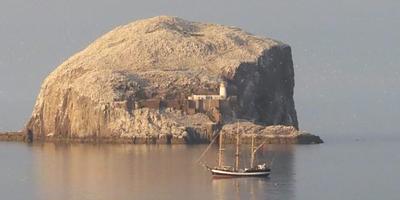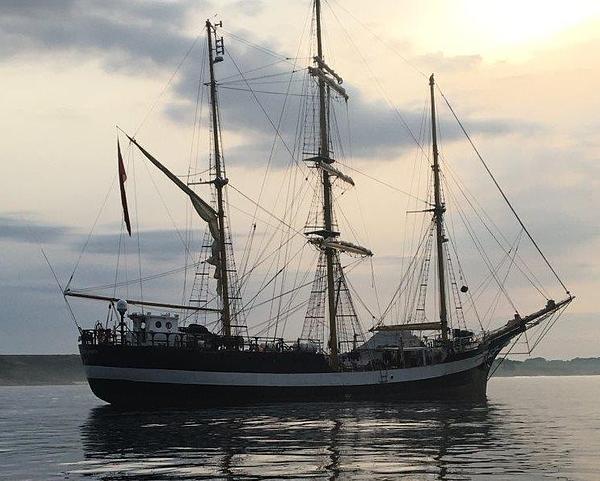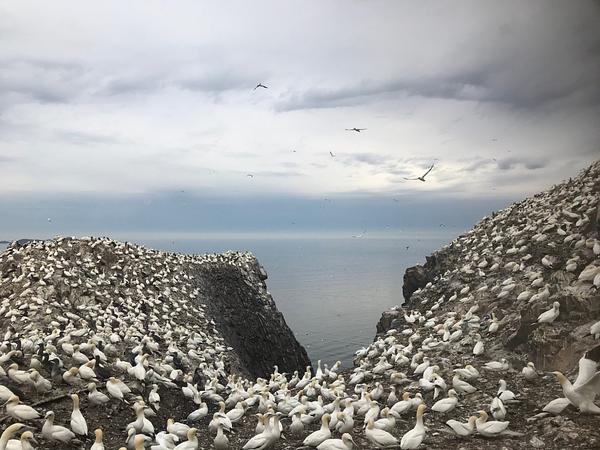
Darwin 200 - broadcast live from the Bass Rock
The team were joined by students, researchers and film crew from ‘Darwin200’ – a project that provides university students the opportunity to take part in environmental studies on a research boat, just as Charles Darwin did 200 years ago, and share their findings as they go.
The central themes of the project are: “adventure of science, discovery and exploration, inspired through following Charles Darwin’s voyage and the research and outreach activities that will engage hundreds of millions of people around the world”.
The lucky students selected to take part are a mix of keen sailors, scientists and nature enthusiasts from a variety of different backgrounds and circumstances. As they travel, they assist with the day to day running of the ship (such as night watches and cooking), receive training from experts in marine science and make new friends, all whilst living onboard a beautiful tall ship with state-of-the-art research and communications equipment.
The crew conduct various research projects as they go, including surveys of marine mammals and the abundance of plastic in the ocean. Findings are showcased to schools and the general public through videos, interviews and photos and involvement in citizen science projects is encouraged.
This year sees the crew circumnavigating the UK – a pre-cursor to next year’s ‘main event’ of a world-wide voyage following Darwin’s route on HMS Beagle. When the Seabird team met them, they had already travelled from Sharpness Harbour Gloucester, up the West coast and over the top of the mainland of Scotland, before arriving in the Firth of Forth. Here they were ready to meet the fantastic Northern gannets of the Bass Rock. Thankfully, the bad weather that had prevented them landing on other locations in Scotland had completely vanished the morning of their arrival and the group were greeted with clear skies, still air and calm seas.

Landing on the Bass was quite a treat for the students. Access permission, which is managed to protect the nationally and internationally important seabirds, was kindly given by the owner – Sir Hew Dalrymple. The Bass Rock is both a Site of Special Scientific Interest (SSSI) and forms part of the Forth Islands Special Protection Area (SPA).
Once on the island, the students received a welcome and safety talk from Maggie and the team and were then carefully led up the steps, past the iconic lighthouse, to the heart of the colony. At this time of year, Bass Rock is home to roughly 150,000 Northern gannets. With so many co-inhabiting less than 5 acres of rock, the density of birds is incredible. Standing amongst them is like being in the middle of a seabird city full of noisy, smelly, irritable neighbours! Students and staff couldn’t help but utter “wow” and “there are so many!” regularly throughout the day.

Whilst the students took in the moment, the professional cameramen and drone pilots captured incredible footage of the gannets, the island and surrounding views across the firth. The day wasn’t just about providing those on the island with an incredible experience. Shots were captured that will be incorporated into a short film and Maggie and the Scottish Seabird Centre Team were also involved in 2 live streaming events – one to Orkney Science Festival and another to ‘Exploring by the seat of your pants’, an initiative that streams science into classrooms all around the world.
Thanks to technology, the beauty of the Bass can be appreciated by thousands of people that would otherwise not be able to. Not only that, it provides an opportunity for people to see the impact of human activities on wildlife for themselves. Sadly, we found plenty of plastic pollution amongst the colony during the day, but Darwin200 used the opportunity to capture footage and discuss the dangers of pollution during their live streaming sessions.
Presenting information this way is an incredibly powerful way to introduce important conservation messages and engage people in green practices. The project therefore provides huge benefits to the environment, as well as science and society.
With the environment facing ever worsening threats, projects like Darwin200 are needed more now than ever. We wish the team all the very best with the rest of their journey around the UK and their global voyage next year!
Find out more and follow their progress here: https://darwin200.com/
